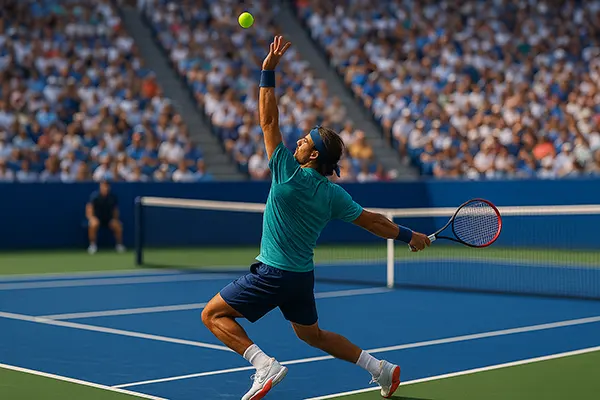The year 2025 has become a turning point in the history of tennis, as electronic officiating systems are now officially applied across all professional tournaments. This decision by the ATP, WTA, and ITF has marked a new era of fairness and consistency in the sport, eliminating controversial human errors and ensuring a unified standard of judging for players and fans worldwide. While traditional line judges had been gradually replaced in certain competitions over the past years, the full-scale implementation across all levels of the sport is an unprecedented move that continues to spark debates, admiration, and adaptation challenges.
The Path Towards Electronic Officiating
The use of electronic line-calling technologies such as Hawk-Eye and Foxtenn has been part of tennis for nearly two decades. Initially applied only in selected tournaments and under certain conditions, these systems provided a backup to human judges. However, growing concerns about accuracy, fairness, and the pressure on umpires led to broader adoption. The COVID-19 pandemic accelerated this trend, as tournaments sought to reduce on-court staff numbers, which highlighted the efficiency of automated calls.
By 2023, some of the most prestigious events, including the US Open and Australian Open, fully transitioned to electronic line-calling. Other tournaments tested hybrid models, but the positive feedback from players and organisers encouraged a move towards complete standardisation.
The decision announced in late 2024 to implement electronic officiating at every tournament in 2025 was therefore not surprising. It represented a logical continuation of a process that had long been underway, ensuring the sport embraced technological progress in a consistent and transparent way.
Impact on Players and Matches
For players, the introduction of full electronic officiating has significantly changed the dynamics of matches. No longer do players spend energy challenging calls or disputing decisions with umpires. Instead, the game now flows without interruptions, with instant and indisputable calls ensuring a smoother rhythm.
Psychologically, athletes benefit from reduced frustration, as the perception of unfairness is minimised. While some miss the human interaction and the drama that line disputes brought to the sport, the overwhelming sentiment among professionals is relief at having a clear and fair system.
Additionally, the pressure on chair umpires has decreased. With line calls fully automated, umpires can now focus on managing the match, ensuring rules are followed, and maintaining order, which in turn enhances the overall atmosphere of tournaments.
Technology Behind the Change
The success of electronic officiating depends heavily on advanced camera systems, motion sensors, and high-speed data processing. Hawk-Eye, which remains the most widely recognised system, uses multiple high-definition cameras around the court to track the ball in real time and generate a 3D representation of its trajectory. Other providers, like Foxtenn, rely on ultra-fast cameras capable of capturing up to 2,500 frames per second, offering even greater precision.
The International Tennis Federation has stressed that rigorous testing was conducted before the global rollout. The systems now in use meet strict accuracy standards, with an error margin measured in millimetres, far below the margin achievable by human eyesight. This consistency ensures that every match, from Grand Slam finals to lower-tier ITF events, is governed by the same level of accuracy.
Importantly, the technology has also been designed to integrate seamlessly with broadcast systems, offering television audiences real-time replays of calls, which enhances viewer trust and engagement.
Challenges and Criticisms
Despite its many advantages, electronic officiating has not been welcomed without criticism. Purists argue that removing human line judges takes away a part of the sport’s tradition and atmosphere. The sound of a line call, the tension of challenges, and the drama of disputed points had long been integral to the experience of live tennis.
Another concern relates to accessibility and costs. While major tournaments can afford to implement and maintain sophisticated technology, smaller regional events may struggle with financial and logistical challenges. Governing bodies have responded with subsidy programmes and gradual implementation plans to ensure that lower-level competitions are not left behind.
Finally, there is the issue of reliance on technology itself. System failures, though rare, have occurred, and ensuring continuous reliability requires constant investment in maintenance and updates.

The Future of Tennis Officiating
Looking ahead, electronic officiating is expected to evolve even further. Developers are already working on integrating artificial intelligence that could help with more complex rule enforcement, such as detecting time violations, foot faults, or even player conduct issues.
There is also the possibility of enhancing fan engagement through data visualisation, offering audiences deeper insights into match dynamics and ball trajectories. This would not only add entertainment value but also increase transparency.
For players, coaches, and analysts, access to precise and reliable data from officiating systems could reshape training and preparation methods. Tactical adjustments, based on real-time statistics, may become as important as physical and technical skills.
Global Reactions and Long-Term Outlook
Reactions to the full introduction of electronic officiating in 2025 have been mixed but predominantly positive. Many players, especially younger generations, see it as a natural and overdue step, aligning tennis with modern expectations of fairness and precision. Veteran players, however, often express nostalgia for the human element, though most acknowledge the practical benefits.
Fans too are divided. While television audiences enjoy the enhanced clarity and speed of matches, spectators in stadiums sometimes miss the drama of on-court disputes. Organisers are therefore exploring ways to maintain excitement through other innovations, such as immersive fan experiences and interactive broadcasts.
In the long term, electronic officiating is expected to strengthen tennis as a global sport, making it more appealing to younger audiences who value technology-driven fairness. By embracing these systems, tennis is ensuring its relevance and competitiveness in the evolving world of professional sports.
